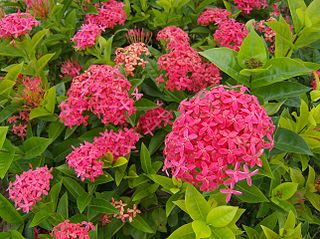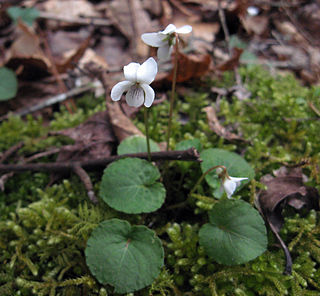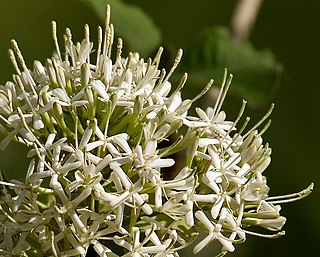
Ixora is a genus of flowering plants in the family Rubiaceae. It is the only genus in the tribe Ixoreae. It consists of tropical evergreen trees and shrubs and holds around 562 species. Though native to the tropical and subtropical areas throughout the world, its centre of diversity is in Tropical Asia. Ixora also grows commonly in subtropical climates in the United States, such as Florida where it is commonly known as West Indian jasmine. Other common names include viruchi, rangan, kheme, ponna, chann tanea, techi, pan, siantan, jarum-jarum/jejarum, jungle flame, jungle geranium, and cruz de Malta, among others. The plants possess leathery leaves, ranging from 3 to 6 inches in length, and produce large clusters of tiny flowers in the summer. Members of Ixora prefer acidic soil, and are suitable choices for bonsai. It is also a popular choice for hedges in parts of South East Asia. In tropical climates they flower year round and are commonly used in Hindu worship, as well as in ayurveda and Indian folk medicine.

Pavetta is a genus of flowering plants in the family Rubiaceae. It comprises about 350 species of trees, evergreen shrubs and sub-shrubs. It is found in woodlands, grasslands and thickets in sub-tropical and tropical Africa and Asia. The plants are cultivated for their simple but variable leaves, usually opposite but also occur in triple whorls. The leaves are often membranous with dark bacterial nodules. Pavetta has small, white, tubular flowers, sometimes salviform or funnel-shaped with 4 spreading petal lobes. The flowers are carried on terminal corymbs or cymes.
Pavetta holstii is a species of plant in the family Rubiaceae. It is endemic to Tanzania.
Pavetta intermedia is a species of plant in the family Rubiaceae. It is found in the Democratic Republic of the Congo and Uganda.
Pavetta kupensis is a species of plant in the family Rubiaceae. It is endemic to Cameroon. Its natural habitat is subtropical or tropical moist montane forests.
Pavetta lasioclada is a species of plant in the family Rubiaceae. It is found in Burkina Faso, Cameroon, Ivory Coast, Ghana, Guinea, Mali, Sierra Leone, and Togo. It is threatened by habitat loss.
Pavetta linearifolia is a species of plant in the family Rubiaceae. It is found in Kenya and Tanzania.
Pavetta manyanguensis is a species of plant in the family Rubiaceae. It is endemic to Tanzania.
Pavetta mollissima is a species of plant in the family Rubiaceae. It is found in Ghana and possibly Ivory Coast. It is threatened by habitat loss.
Pavetta monticola is a species of plant in the family Rubiaceae. It is found in Equatorial Guinea and São Tomé and Príncipe.
Pavetta rubentifolia is a species of plant in the family Rubiaceae. It is endemic to Cameroon. Its natural habitats are subtropical or tropical moist lowland forests and subtropical or tropical moist montane forests. It is threatened by habitat loss.
Pavetta sparsipila is a species of plant in the family Rubiaceae. It is endemic to Tanzania. Pavetta sparsipila is classified as Vulnerable (VU) on the IUCN Red List

Viola blanda, commonly called the sweet white violet, is a flowering perennial plant in the Violet family (Violaceae). It is native to parts of south-eastern and south-central Canada and the eastern, and north-central, United States. Its natural habitat is in cool, mesic forests.

Anemonoides blanda, syn. Anemone blanda, the Balkan anemone, Grecian windflower, or winter windflower, is a species of flowering plant in the family Ranunculaceae. The species is native to southeastern Europe and the Middle East. The specific epithet blanda means "mild" or "charming". The genus name is derived from the Greek word anemos, or wind.

Ixora pavetta, the torch tree, is a plant in the family Rubiaceae. This species is found in South Asia. The species is commonly seen in Ballari district of Karnataka, India. It is called as goravi (ಗೊರವಿ) in Kannada. People use the branches of this tree for making walls and paste with mud for their thatched huts in villages, but now this practice has become obsolete owing to modern housing materials.
Pavetta kimberleyana is a species of plant in the family Rubiaceae. It is native to northern Australia where it is largely restricted to the Kimberley region of north-western Western Australia.

Pavetteae is a tribe of flowering plants in the family Rubiaceae and contains about 624 species in 9 genera. Its representatives are found from the tropics and subtropics of the Old World and the southern Pacific region.

Ixora chinensis, commonly known as Chinese ixora, is a species of plant of the genus Ixora.
Pavetta schumanniana, the poison bride's bush, is a species of plant described by F.Hoffm. and Karl Moritz Schumann. Pavetta schumanniana is part of the genus Pavetta and the family Rubiaceae. No subspecies are listed in the Catalog of Life.






